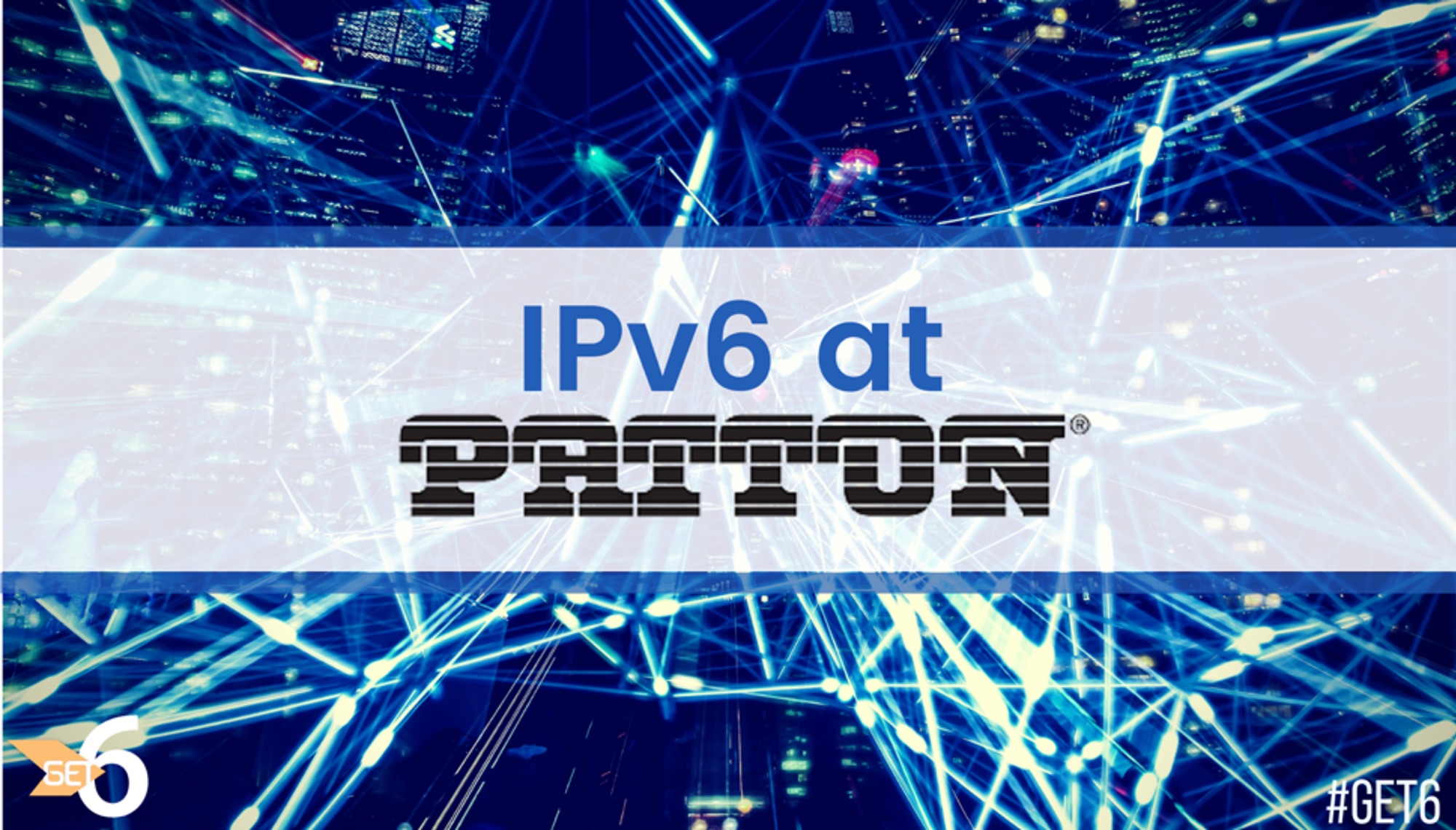
Demand for IPv6 Warrants Development Efforts
Patton IPv6 Case Study
Patton saw IPv6 coming, so we knew the company had to get ready for it. We are a networking equipment manufacturer for Voice-over-IP (VoIP) gateways and eSBCs, Ethernet extension solutions, and wireless routers. Our specialty is interconnecting legacy time-division multiplexing (TDM) and serial systems with new-generation, IP-based voice, data, and multi-media technologies. Patton supports IPv6 in its operating system and hardware platforms for the SmartNode line of VoIP customer-premise equipment (CPE). In 2011, the company started designing hardware that would support IPv6. During the years that followed, we waited for market demand to catch up with in capabilities. In 2018, enterprise and carrier markets finally raised sufficient demand to warrant the necessary development effort to complete IPv6 support. Most of the carriers we work with that serve small-to-medium enterprises (SME) have begun adopting IPv6 in their networks.

Mind the gap
To begin, the engineering team developed a step-wise process to identify the gaps between what they wanted to do and where things were in Patton’s IPv6 strategy. Developers listed the features, functions, services and applications. They evaluated the available elements in the supply-chain that could address the transition issues and enable us to complete our ultimate IPv6 plan. The process looked a lot like this:
-
Establish development environment: tools, test lab, test equipment, etc.
-
Specification Phase:
-
Define minimum viable product, feature roadmap, development phases, release cycles
-
Define network topology
-
Device management (local configuration)
-
Device management services (remote management, provisioning, AAA, file management, etc.)
-
IPv6 features/services (routing, DHCPv6, DNS over IPv6 and AAAA record handling)
-
Applications
-
-
Define Operations Concerns
-
IPv6 transition mechanism (dual stack considerations, NAT64, DNS64, 464XLAT, etc.)
-
IPv6 translation mechanism (IPv4 <-> IPv6)
-
-
Deployment setup & tools
-
Staging environment – deployment verification, feature testing, stress test, problem collection
-
Production environment
-
To date, Patton supports all the necessary functions over IPv6: SIP, DHCPv6, access control list (ACL), domain name server (DNS) client, SSH and Telnet access. These functions enable the SmartNode targeted services to work.
Edge orchestration services
Patton specifically designed its cloud service for network edge orchestration to support IPv6. A number of our carrier customers have deployed IPv6 on Patton VoIP CPE—including enterprise session border controllers (eSBC) and VoIP gateways.
We have tested and proven SmartNode CPE with carrier customers for Session Initiation Protocol (SIP) trunk service delivery using IPv6. For a carrier, deploying customer premise equipment can be an expensive prospect. On-site installation and turn-up may require a truck-roll to the customer location or employing the service of a third-party integrator. Patton has taken various steps to reduce a carrier’s deployment costs, but edge orchestration provides completely automated, touchless CPE provisioning. Historically, changes to networks and services have often required a technician to visit the customer site. Now, with edge orchestration services from the Patton Cloud, network services can be added, removed, and provisioned via remote access to the CPE on the subscriber site. By implementing enhanced IPv6 in SmartNode VoIP CPE, Patton delivers simplified network architectures with lowered operation and maintenance costs for service providers and enterprises.
In scenarios where a network is running IPv4 but needs to connect to services via IPv6, SmartNode devices handle the conversion seamlessly. To learn more about the SmartNode configuration wizard, and find out how to set up IPv6 on your SmartNode, visit the Patton blog:
Why support IPv6?
The move to IPv6 is inevitable, and there is good reason to do it sooner rather than later.
Initially, Patton decided to implement IPv6 because it eliminates Network Address Translation (NAT). NAT is complicated and increases loads on the processing power of every device in the network. Peer-to-peer networks are much easier to create and maintain. These issues are now especially significant given the rise of the Internet of Things (IoT)—with applications ranging from industrial networking to device-based communications. Getting rid of NAT reduces the complexity of the network and lowers the demand on device processing power.
Another driver for Patton’s IPv6 development effort was the robustness of IPv6 for services like VoIP and Quality of Service (QoS). Overall, functions that have been added to IPv4 over a long period of time were designed into IPv6 from the beginning. Management visibility is much finer-grained. Each device can be remotely monitored and controlled without interference imposed by varied network topologies, NAT hops, and so on.
As a further benefit, there are fewer attack vectors in IPv6 and fewer opportunities for “man-in-the-middle” attacks. We like the encryption and IPSec built into IPv6 and wanted those features in their products.
The biggest obstacle we encountered in deploying IPv6 is that some ISPs do not yet support IPv6. This gap in the ISP market required us to create tunnels in order to run IPv6 over IPv4. Tunneling requires more intelligence in the CPE, but SmartNode hardware and software were pre-designed to handle such tasks.
Experience = confidence
We took a low-risk approach by developing new services to deploy over IPv6, rather than disrupting an installed base. This allowed us to make basic plans and work initially with friendly customers on a small scale. By this method, we also learned a lot about the transition issues that would be faced on larger deployments. As with anything new or unknown, IPv6 is only scary as long as it remains new or unknown.
With a little experience, confidence grows and so too can your plans and your profits.
Any views, positions, statements, or opinions of a guest blog post are those of the author alone and do not represent those of ARIN. ARIN does not guarantee the accuracy, completeness, or validity of any claims or statements, nor shall ARIN be liable for any representations, omissions, or errors contained in a guest blog post.
Recent blogs categorized under: IPv6
GET THE LATEST!
Sign up to receive the latest news about ARIN and the most pressing issues facing the Internet community.
SIGN ME UP →Blog Categories
RPKI • Updates • Outreach • Internet Governance • Grant Program • Tips • IRR • IPv6 • Public Policy • Caribbean • Elections • ARIN Bits • Fellowship Program • Training • Security • Guest Post • Data Accuracy • Business Case for IPv6 • IPv4 • Customer Feedback





